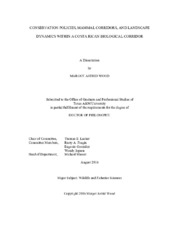| dc.description.abstract | The Payments for Environmental Services (PES) goals, in place in 1997, focus on preservation of biodiversity, scenic beauty, watershed protection, and carbon sequestration, whereas the National Biological Corridor Program (NBCP) focuses on sustainable development to increase connectivity within biological corridors. New legislative actions in 2006 and 2014 have placed spatial bounds on PES funding based on the NBCP official corridors. Due to these conservation policy changes and differing goals, it is important to critically analyze the spatial needs of each policy goal across a heterogeneous biodiversity landscape and a variety of ownerships regimes. In this research I analyzed the efficiency of targeted PES and the NBCP by classifying ASTER 15-meter resolution imagery using object-based classification methods, and compared land cover changes over an initial four-year period of corridor policy enactment. I examined the changes in overall mammal connectivity, and the role of PES properties within the study corridor by mapping connectivity through Circuitscape and least-cost path modeling. Lastly, I used Marxan to model potential reserve networks that aim to meet the specified policy goals of these two conservation programs.
Results indicate a decline in forest over the study time period, along with an increase in urban and pasture land covers. Results from connectivity analyses show PES properties hold a wide variety of species and guild richness, with higher richness in forest protection than reforestation. I established that active PES properties after NBCP played a larger role in connectivity compared to PES properties before. Overall connectivity within the study region has decreased since program enactment. Results from Marxan models indicate that goals within these two programs have differing spatial requirements, especially regarding watershed protection. PES policies targeted within biological corridors must act on present and future drivers of change to accomplish connectivity goals throughout Mesoamerica my results indicate the importance of PES for mammal communities, and the necessity for increased targeting of payments to existing forested corridors, to provide connectivity between protected areas. Multi-goal programs must determine which goals are most important and can strategically select goals with the highest overlap to accomplish the highest returns. | en |


